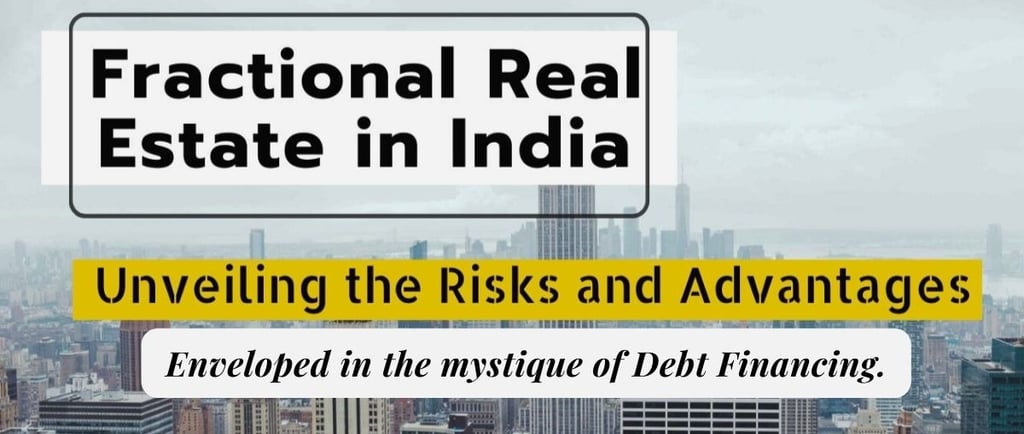
Own a Share in Premium Residential & Commercial Properties Starting from Just ₹15 Lakhs. Secure, Profitable, and Accessible Investments Await!
The Benefits of Debt Financing in Fractional Ownership: A Practical Guide for Retail Investors
Dive into the world of fractional ownership and discover how savvy investors leverage debt financing to maximise returns on high-value assets like real estate. Explore practical examples and calculations in Indian Rupees (INR), learn the pros and cons of debt financing, and uncover strategies for optimising your investment portfolio.
3 min read


Are you a salaried individual/ Retail Investor dreaming of dipping your toes into the world of real estate investment? It might seem like a distant dream, but fear not! Fractional ownership combined with smart debt management can turn that dream into a tangible reality. Let's embark on a journey to explore how you can leverage debt to your advantage, with practical examples and calculations, making real estate investment more accessible and understandable for you.
Imagine yourself, Aman, a salaried professional in India, looking to build wealth through property. You're interested in a 25 lakh INR of Investment that boasts an average rental yield of 8.5% p.a. This means you can expect to earn 2,12,500 INR annually in rent (25,00,000 x 8.5%). Sounds good, right? But wait, there's more! Property also offers potential for capital appreciation, the fancy term for the increase in value over time. Let's assume a conservative estimate of 6.5% annual appreciation.
Now, to make this a reality, you're considering a loan. We'll explore two scenarios:
Scenario 1: Loan amount - 15,00,000 INR
Down payment: You'd pay 10,00,000 INR from your savings (25,00,000 - 15,00,000).
Loan interest: We'll consider two options: 9% and 11%.
Monthly EMI (Equated Monthly Installment): This is what you'll pay back to the bank each month.
At 9% interest: Your EMI would be around 18,700 INR per month (assuming a loan term of 15 years).
At 11% interest: The EMI would be around 21,300 INR per month (assuming the same loan term).
Rental income vs. EMI: Here's the interesting part. The 2,12,500 INR annual rent you receive from the property can be used to offset the EMI. This reduces your actual cash outflow.
Understanding the impact of interest rate:
At 9% interest: With rent income used for EMI payment, you'd be left with a surplus of around 2,550 INR each month (2,12,500 - (18,700 x 12)). This surplus can go towards building your equity and savings.
At 11% interest: The higher interest rate means a smaller surplus of around -650 INR per month (2,12,500 - (21,300 x 12)). This translates to a net outflow, but remember, the property value is appreciating!
Scenario 2: Loan amount - 10,00,000 INR
Down payment: You'd pay 15,00,000 INR upfront from your savings (25,00,000 - 10,00,000).
Loan interest: Again, we'll consider 9% and 11%.
Monthly EMI:
At 9% interest: Your EMI would be around 12,460 INR per month (assuming a loan term of 15 years).
At 11% interest: The EMI would be around 14,500 INR per month (assuming the same loan term).
Rental income vs. EMI in Scenario 2:
At both 9% and 11% interest: With a lower loan amount, the rent income would comfortably cover the EMI, leaving a surplus of around 8,790 INR per month (2,12,500 - (12,460 x 12) for 9% interest and 2,12,500 - (14,500 x 12) for 11% interest). This surplus can significantly accelerate your wealth building.
Remember, this is a simplified example. There are other factors to consider, like property taxes, maintenance costs, and vacancy periods (it may differ from property to property). However, it effectively showcases the potential of real estate investment, especially with a long-term perspective.
Key takeaways for Aman (and you!):
Leverage can amplify returns: A loan allows you to control a larger asset with a smaller down payment.
Interest rates matter: A lower interest rate translates to a higher surplus for wealth building.
Consider the long term: Capital appreciation can significantly increase your property value over time.
Diversification: You can diversify your investments across multiple properties or asset classes, reducing risk.
Risk of Default: Defaulting on loan payments can lead to severe financial consequences.
Interest Costs: High interest rates can eat into your returns, as seen in the calculations above.
Market Volatility: Real estate markets can be volatile, impacting the value of your investment.
Conclusion
Debt financing in fractional ownership offers salaried investors/ Retail Investors in India an exciting opportunity to venture into real estate investment. By intelligently leveraging debt, diversifying investments, and reinvesting strategically, you can unlock the potential of your investments and build wealth over time. However, it's crucial to carefully consider the risks and consult with financial experts to make informed decisions that align with your investment goals and risk tolerance.
Do your research, understand the risks, and happy investing!
We're glad you enjoyed this post on "Benefits of Debt Financing in Fractional Ownership". In our newsletter, we delve deeper into these topics and provide actionable tips and strategies to help you achieve your goals in Alternative Asset class.
Stay ahead of the curve and subscribe to our newsletter for the latest insights and solutions!
Still Stuck? Ask Away
Write us at hello@realproft.com with any questions you have about real estate investing. We're here to help you find the perfect way to invest in your future!
Email us: hello@realproft.com
Social media
Subscribe to our newsletter to stay up-to-date with all the latest news and updates. By subscribing, you will receive regular emails containing valuable information, exclusive promotions, and exciting announcements. Don't miss out on this opportunity to join our community and be part of the conversation.
Call us: +91 7678255904
